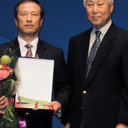Effect of new rotenoid glycoside from the fruits of Amorpha fruticosa LINNE on the growth of human immune cells.
Հիմնաբառեր
Վերացական
A new compound, rotenoid isoflavone glycoside named, 6'-O-beta-D: -glucopyranosyl-12a-hydroxydalpanol was isolated from the methanolic (MeOH) fruit extract of Amorpha fruticosa LINNE by means of multi-stage column chromatography. Immuno-modulatory activities of this new glycoside were compared with the partitioned fractions of Amorpha fruticosa LINNE. Both of the fractions and purified single compound showed a 19% relatively low cytotoxicity at a maximum concentration of 1.0 g/L in a cultivated normal human lung cell line (HEL299). The purified single compound showed less cytotoxicity than the crude extracts, possibly because residual toxicants were eliminated during purification processes. Cell growth of human T cells was increased by about 15% by adding 0.5 g/L of the fractions compared to the control. Specific production rates of interleukin-6 (IL-6) and tumor necrosis factor (TNF-alpha) from T cell were higher as 1.16 x 10(-4) and 1.86 x 10(-4 )pg/cell, respectively, in the purified compound, compared to 1.38 x 10(-4) and 2.22 x 10(-4 )pg/cell, respectively, by adding 0.5 g/L of the dichloromethane fraction. Natural killer cell-92MI (NK-92MI) growth supplemented with the supernatant of human T cell was up to 19% higher with the dichloromethane fraction compared with a new single compound at a concentration of 0.5 g/L. Overall, the dichloromethane fraction showed relatively higher immuno-modulatory activities compared with a new single compound, probably due to the synergic effect given by other substances existing in the fractions.


